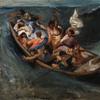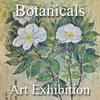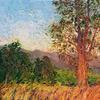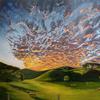Charles White: Influences
- WEST NYACK, New York
- /
- February 10, 2022
In West Nyack, New York, Rockland Center for the Arts (RoCA) will present for its 75th Anniversary year, Charles White: Influences, an exhibition in partnership with the Gordon Center for Black Culture & Arts and the CEJJES Institute. White was one of the most influential African-American artists and celebrated draftsman working in the twentieth century. He was best known for depicting people of color in both heroic, and realistic, socially, culturally and historically. White’s portraits reinforced the dignity, humanity, and beauty of the black figure. He was a socially conscious, politically active, and inspirational teacher and influencer.
Charles White: Influences will open on April 2nd, 2022 in honor of the artist’s birthday and will be on view through June 11, 2022. The exhibit will trace the trajectory of his most influential relationships: both those acolytes his work influenced through generations and those progenitors who influenced and informed his work. This exhibit will act as a testament to his lasting significance as an artist, activist, and educator.
Included with the exhibition will be: a one act play by Samuel Harps; a panel discussion on the legacy of Charles White; a virtual lecture on starting an art collection of African-American artists and others; community workshop activities and additional exhibits of community artworks. The exhibit, play, workshops, panel discussions, and lectures will all be free of charge and open to the public.
Charles White was interested in art from the age of seven when his mother gave him a painting set, which he would take to the park to paint with students from the Art Institute of Chicago. He spent many hours in the library, reading African-American history and drawing from art magazines. He often questioned his teachers as to why these prominent black figures were missing from the accounts of American history. While only in seventh grade, he was one of 500 Chicago public school students to receive a scholarship from the James Raymond Nelson Fund. With the scholarship, he attended Saturday art classes at the Art Institute of Chicago, receiving instruction from artist such as Ivan Albright. One particularly inspiring teacher, George Neal, took his students into the street and made them conscious of the beauty of their, occasionally, dilapidated surroundings. He also made them deeply aware and proud of the revolutionary idea of the beauty of black people.
Neal took a handful of promising students, including White, Margaret Burroughs, Eldzier Cortor and Charles Sebree, and shaped them into a group called the Arts Craft Guild. The Guild would display their work for larger audiences, including the Exhibition of the Art of the American Negro, part of the American Negro Exposition held at the Chicago Coliseum to mark the 75th anniversary of abolition. The Arts Crafts Guild continued to encourage activism and support for African-American art and literature throughout the 1930s and 1940s.
White’s intellectual ideas about the African-American community were additionally influenced by Alain Locke’s book, The New Negro, and by Polish émigré artist Morris Topchevsky’s moral compass. However, much of the society of the time continued to muddle through the racial viciousness that proliferated after the American Civil War and the destruction of institutionalized slavery. Years before, Charles White had entered two art competitions for scholarships in Chicago and won—only to be told when he arrived to receive the award, a mistake had been made—a racially motivated snub. In May of 1937, after two attempts to enter art school, Charles White won a one-year scholarship to attend the Art Institute of Chicago. He completed the two-year program in one.
The south side of Chicago would connect him to a “who’s who” of renowned talents: in addition to printmaker and artist Eldzier Cortor, he met singer Nat “King” Cole and photographer Gordon Parks. A Julius Rosenwald Fellowship in 1942 enabled him to move to New York, with wife, Elizabeth Catlett, and study at the Art Students League with Harry Sternberg. The fellowship allowed him to travel throughout the south, conducting research for his next mural, The Contribution of the Negro to Democracy in America, at Hampton institute, Hampton, VA. An additional Rosenwald Fellowship allowed him to create the mural. At Hampton, he befriended art professor Viktor Lowenfeld and his then student, John Biggers, who would go on to create his own well-regarded murals.
A later meeting with Dr. Edmund Gordon, would not only seal a friendship but formed a partnership to change the nation’s perception of African-Americans and those of African descent. Dr. Gordon along with other black community leaders, underwrote the Gil Noble TV show on ABC,“Like it is with Gil Noble.” Dr. Gordon introduced Mr. Noble to Charles White’s artwork, which ultimately was shown at the beginning of each of the shows – a powerful example of what the Black Economic Collective could do culturally and economically. Dr. Edmund Gordon would collect a considerable number of White’s artworks and later donate to the Blanton Museum at the University of Texas. White’s later friendship with Harry Belafonte would also garner his works being shown on Belafonte’s television series.
An artist-in-residence at Howard University in 1945 was followed by travel and study in Mexico. While studying lithography at the Taller de Gr’afica Popular de Mexico, he was inspired by the murals of Edward Millman and Diego Rivera. It was their influence that he used when painting murals for the Illinois Art Project and the Works Progress Administration (WPA). He was now better able to give a shape and a voice to everyday individuals and laborers, as seen in Kitchenette Debutantes and Five Great American Negros. During his years with the (WPA,) he worked as an easel painter and then in the mural division, painting a five-by-twelve-foot canvas depicting Sojourner Truth, Booker T. Washington, Frederick Douglas, Marian Anderson and George Washington Carver, the Five Great American Negroes. He was also commissioned, during this time, by the Associated Negro Press to create The History of the Negro Press. Three of these artworks were included in the Library of Congress exhibition The Art of the American Negro.
White’s career of drawing, painting, and graphics were representational art of social concern, with profound feeling and resonant of human dignity. His masterpiece artworks reflected his commitment to social and economic justice, the human condition, and empowering the black masses. He was determined to defend the achievements of his people against the misinformation and grotesque stereotypes that affronted them in books, motion pictures, cartoons, newspapers, jokes, and advertisements. In 1940, White told an interviewer: “I am interested in the social, even the propaganda, angle of painting. . .. I am interested in creating a style of painting that is much more powerful, that will take in the technical end and at the same time, say what I have to say. Paint is the only weapon I have with which to fight what I resent.”
During the 1950s despite great changes in the postwar fabric of American life, there were still times when, as a black man, White would not be permitted to enter a gallery or museum where his works were being exhibited. He would say he couldn’t allow prejudice to get in the way of his artistry, and that he had to speak in the language of artistry, not through anger.
As a social realist he depicted the downtrodden, to advocate for their equity, social mobility, and the perseverance of ordinary working people. Throughout his life he created works with a visual language of power and gestural eloquence, representing the soul beauty of a people at work and the injustices of human kind. They stand as defiant and proud figures, poetically fortified with justice for all oppressed people.
I’ve Been ‘Buked and I’ve Been Scorned, featured in the exhibit, shows a woman standing in a doorway, with a view through a narrow shack to an open window beyond. She is older, perhaps a grandmother. She seems to be telling us a story, perhaps her history. The figure is maternal and intimidating. As an artist, White seems to be saying that if we listen carefully to this person, we might get through to the other side and understand as a fellow human being that the trials and tribulations are similar in all our struggles.
White had an overwhelming concern for those living in poverty. His series of charcoal and mixed-media drawings called the “Wanted Poster Series” express his sensitivity to the misfortunes of others. The themes of this series of drawings are slavery, segregation, and man’s inhumanity to man. These subjects were inspired by the struggle for black equality led by Dr. Martin Luther King Jr.
One of the later works in the exhibit, The Prophet, 1975, has no compelling symbols to move the viewer across the axis of the composition to ensure classical balance. The prophet, the dominant theme in the composition, is depicted as a common man clad in a simple robe. He gazes both upward and outward toward a red rose, which seems to be suspended in time and space. The fervent gaze says all that needs to be said about the quiet dignity of a prophet, a seer. On the cross-hatched walls in the background, four eyes stare out at the viewer. Once, at the time of his lectures, White was asked about the eyes; he said that they were there because the prophet sees more than the rest of us. (“ ‘I have a Dream: I Have Seen Black Hands,’ ” David Driskell, Christian Science Monitor, 1/1988). As time had progressed, once realistically-presented figures, honorably presented but still rooted in the familiar, gained the same energy and importance as ancient totemic figures. They illustrated ideas grounded in the present that were invested with the mythic.
In 1950, he married Francis Barrett, and they eventually moved to Los Angeles. In this latter part of his life, he taught art at Otis University in California. White’s name is synonymous with his many well-known students. When teaching he asked his students three questions: Where do you come from? Why are you doing this? and How do you know who you are? White felt you should know yourself and that knowing should show in your work.
Charles White received many awards, including a John Hay Whitney Fellowship in 1955, an award and exhibit from the national Academy of Design in New York in 1971, and a gold Medal from International Grafik, Berlin in 1977. He was honored posthumously at the White house by Jimmy Carter in 1980. And his work is included in many collections, including the Whitney Museum of American Art, The Metropolitan Museum of Art, the Art Institute of Chicago, the Los Angeles County Museum of Art, the Library of Congress, the Hirschhorn, the Newark Museum, and the Oakland Art Museum, as well as in private collections.
The exhibit will demonstrate that White’s commitment to social and economic justice, not only were monuments of human dignity, but emboldened his students to create impactful works of supple power and gestural eloquence to impact the local communities and extend globally. White’s intention in art was to portray the lifestyle of his people with symbols that were both recognizable and visually relevant. This explains why his art is immediately understandable and accessible to all.
This exhibit will also feature works and ephemera by those who carried White’s lessons into their own work. We will follow the trajectory of White’s students, exhibiting the works of artists such as Kerry James Marshall, David Hammons, as well as second generational influences of Alonzo Adams, Mequitta Ahuja, and Kadir Nelson. Third generational influences of White can be seen in works by Dionis and Jose Ortiz and Kyle Adams.
Also on view:
"See, Observe, Think, Reflect, Internalize"
Photography by Collette V. Fournier
Opening Reception: Saturday, April 2, 2:00-5:00pm
On view through June 11, 2022 in Gallery One & Gallery Two
A documentation of photographer and photojournalist Collette V. Fournier’s travels around the globe, beyond her search for roots of African-American people and how the history of black servitude was acknowledged in Africa.

100x100_n.jpg)

100x100_c.jpg)










100x100_c.jpg)

